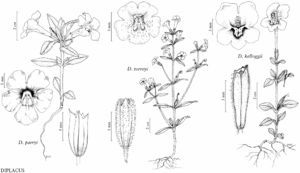Diplacus kelloggii
Phytoneuron 2012-39: 32. 2012.
Herbs, annual. Stems erect to ascending, 10–310(–370) mm, glandular-puberulent and/or glandular-pubescent. Leaves usually basal, sometimes basal and cauline, relatively even-sized; petiole absent, larger with petiole-like extension; blade obovate to elliptic, (4–)6–40(–52) × (2–)3–17(–26) mm, margins entire or crenate, plane, apex obtuse, surfaces often pubescent. Pedicels 2–6(–10) mm in fruit, usually twisting to invert calyx. Flowers 2 per node, or 1 or 2 per node on 1 plant, chasmogamous. Calyces distinctly asymmetrically attached to pedicel, not inflated in fruit, (7–)8–16(–17) mm, densely glandular-puberulent or glandular-pubescent, lobes subequal, apex obtuse, ribs purplish, intercostal areas whitish. Corollas: throat dark purple, golden yellow at base with reddish speckling, limb magenta to reddish purple, lateral adaxial lobes each with a dark purple basal spot, palate ridges golden yellow, tube-throat (13–)20–45(–50) mm, limb 10–18 mm diam., bilabiate, abaxial lip smaller than adaxial. Anthers (distal pair) exserted, glabrous. Styles densely glandular-puberulent distally. Stigmas exserted, lobes unequal, abaxial 4–5 times adaxial. Capsules 6–12(–13) mm, indehiscent. 2n = 18.
Phenology: Flowering Mar–Jun.
Habitat: Near water runoff areas, away from seeps or other areas with prolonged moisture.
Elevation: 50–1500 m.
Discussion
Diplacus kelloggii occurs in southwestern Oregon and broadly in northern California.
Selected References
None.
